Denos' Uni High Engineering Class Designs Assistive Devices for Senior Citizens
March 14, 2016
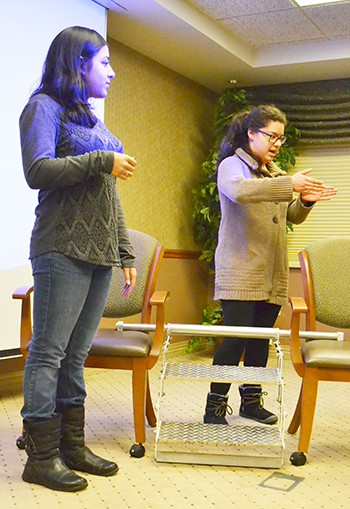
Two Uni High students present the step they designed to assist seniors entering an automobile.
Engineering is about more than just designing things; it’s about making a difference in people’s lives. This is one key principle Uni High Engineering teacher Sharlene Denos tries to instill in her students. So she’s always on the lookout for projects her class can do to give back to the community. Like the air maze they designed and built for the Orpheum in 2014. But they haven’t forgotten the older folks. Denos and company spent time in 2015 designing some devices that provide accessibility for senior citizens. Then in January of 2016, they presented their designs to stakeholders at Clark-Lindsey Retirement Village in Urbana, who vetted the designs and contributed constructive input on how they might be improved.
The students at Uni High (University Laboratory High School) say they learned a great deal through the project. For instance, Lina Flores, a senior, who designed a step to assist seniors when getting into a car, reports: “I definitely learned teamwork and sort of understanding the needs of others. This taught me a lot about how to really appreciate what I have. It was fun. I learned a lot about CAD (computer-aided design) programming, so that was really fun. It was a great experience.”
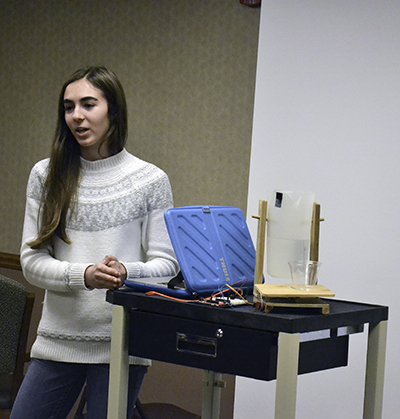
Uni High student Iulianna Taritsa presents the electronic pitcher she and her teammate designed to a group of interested Clark-Lindsey seniors.
Another student, Iulianna Taritsa, reports learning a lot about consumer-aided design—creating a product useful for a certain group of people.
“It's easy to get caught up in a design idea,” she admits. “But returning back to the people you are designing for is so important. The Engineering Explorations class had us bring our prototypes to the Clark-Lindsey residents, show them to U of I engineering students, and even test them on our parents. So being able to test our design and optimize it for other people to use was something we really learned how to do in this class.”
Taritsa indicates that when designing their project—an electronic pitcher that would give an audio cue after the user had poured out a predetermined measurement (i.e., 1/4 of a cup, 1/2 cup, etc.)—she and her partner encountered some challenges along the way, mostly technological.
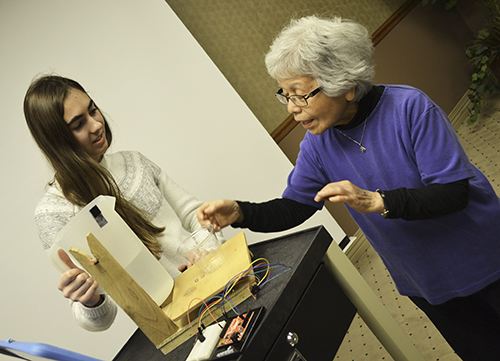
Iulianna Taritsa (left) demonstrates the electronic pitcher to a Clark-Lindsey senior.
For instance, they had hoped to provide cups that change colors with their pitcher, to give a better contrast line to see the liquid through the cup, but couldn’t find a dye that changed fast enough. They had also wanted the pitcher to click and provide resistance depending on the angle being poured, but couldn’t find a simple mechanism to do this.
They also ran into a few challenges related to the use of Arduino, an open-source, programmable microcontroller used for building electronics projects, to program their pitcher.

A Uni High student (right) engages with Clark-Lindsey resident Howard Ross as he tries out the device she designed.
“It was the first time my partner and I were using Arduino; however, in each of these cases, our project either went through a design change to adapt to the obstacles, or we learned how to deal with the issue by spending time researching and learning about it.”
Did Taritsa find the project rewarding? So much so that they even kept working once the semester ended.“Not only did we work on this pitcher for all of the fall semester, but we also continued working after winter break and into January to get our design ready to present at Clark-Lindsey. I know my goal for the engineering class was to have a working prototype by the end.”
Even more rewarding was the first time they successfully used the pitcher. “I distinctly remember the moment when our design worked. We poured a glass of water with the pitcher, and it successfully measured the amount accurately and audibly. After that, my partner and I were full of high-fives and celebratory cheers. Seeing the project finally come together was such a great experience, and made all of the work to get there definitely worth it.”
Another Uni student, Elizabeth Geistlinger, reported that coming up with a project was difficult. "We had to work to find something that would actually be useful to the residents," she explains, "but still be able accomplish in one semester, and by high school students."
She describes some of the challenges her team, which had a common interest in hearing loss, encountered while coming up with a project. "There is so much research out there, and so many products to assist with hearing loss, that we had to talk to some of the residents that had hearing problems to understand what they wanted to change. It ended up not being us helping with a hearing loss issue, but an issue that arose from their hearing aids."
Like Taritsa's group, hers also encountered some technology issues: "We also were trying to 3D print a model of our product, but the way it was designed, the printer would have issues trying to print it."
Geistlinger also learned a bit about leadership. "I also learned even more how to be the team leader. I was the only girl in my group, and 99% of the time, I was the one in charge. I learned that telling people to actually work isn't being mean."
She also learned that age doesn't really matter in regards to helping someone. "I learned that a bunch of high school kids who want to help people, can do so much more than I thought. Some of the things we made were actually useful and the residents liked the ideas."
Like Taritsa, Geistlinger also found their project to be very rewarding. "It was cool to be able to work directly with the Clark-Lindsey residents and figure out what they needed, and how we can help. At the end of my presentation, I got to talk with a resident who was curious about our project and show him how it works. I think that direct contact with the residents is really what made this project worth it."
Not only the students found this cross-generational collaboration to be rewarding. According to Laura Beyer, the Public Relations Coordinator at Clark-Lindsey, her clientele were delighted to help out, for a number of reasons:“Our residents love interacting with students—any young people,” she admits. “That brightens their day. They love helping others learn. Over 60% of our residents have their Masters or PhD, so they are very passionate about education and helping the youth strive to that level as well.”
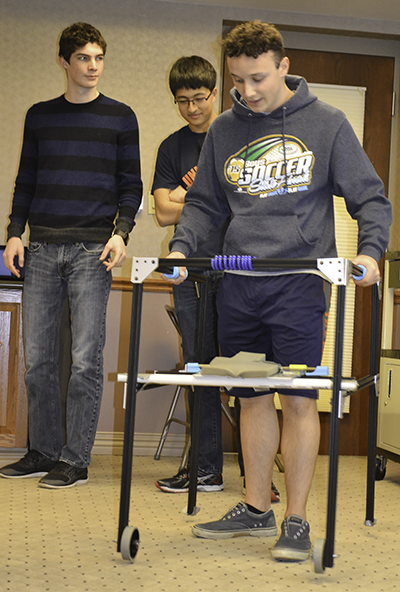
A team of Uni High engineering students present the device they designed: an improved walker.
The fact that the projects might be of some benefit to them personally added to her patrons’ incentive:
“Seeing what innovative ideas that these students come up with not only inspires our residents that there’s hope for the future in whatever area that they’re looking at; it does benefit the aging services as a whole.”
Beyer also indicates that her clientele were excited to have a part in possibly shaping some future engineers: “Whatever these students may go on to do in their futures, whether they become inventors or engineers and are creating these things for real, not just the prototype or the idea but putting it into fruition and making changes in the world.”
The Uni High-Clark-Linsey partnership began in spring of 2015, when Denos’ class competed in CU Make-a-Thon. During this 28-hour community event, teams worked together to build physical prototypes and mock-ups centered on the theme, accessibility for older adults. Participants had been tasked with designing and building an assistive device or improving an existing device that could help senior citizens perform their normal, everyday activities by making it more accessible for older adults to use. Clark Lindsey, which had sponsored the event, also brought residents to be advisors and judges.
Beyer reports that she and Denos met at the Make-a-Thon and realized that a collaboration could be a win-win for both age groups.
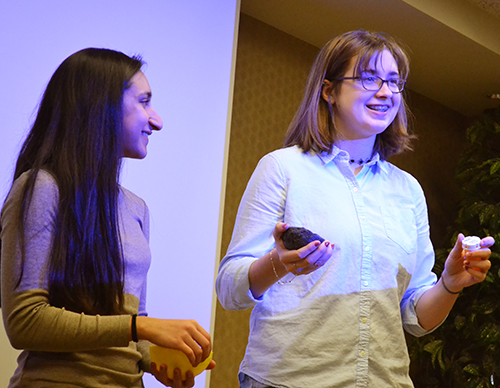
Uni High students demonstrate the device they designed to help seniors remove the cap of their prescription bottles.
“She is teaching an engineering event where they look at a specific population and think about how they can improve their lives to talk about the humanistic side of engineering,” says Beyer. “Since her students, who had come to the Make-a-Thon (which was focusing on older adults), had an interest in this population, we thought we could do a project at Clark Lindsey for her engineering class.”
While the prototypes they designed for the Make-a-Thon had to be finished and presented for the event, the prototypes students revealed at the January 8th presentation at Clark-Lindsey were brand new projects that they had come up with, based on discussions with the Clark-Lindsey seniors, then worked on for the entire fall 2015 semester.
For additional I-STEM articles about the Uni High, see:
- Uni High Engineering Class Makes Wind Maze for Orpheum Museum
- Grand Opening of Orpheum’s Air Maze Celebrates Fluid Mechanics, Rheology
Story and photographs by Elizabeth Innes, Communications Specialist, I-STEM Education Initiative.
More: 8-12 Outreach, Champaign-Urbana Community, Senior Citizens, Uni High, 2016
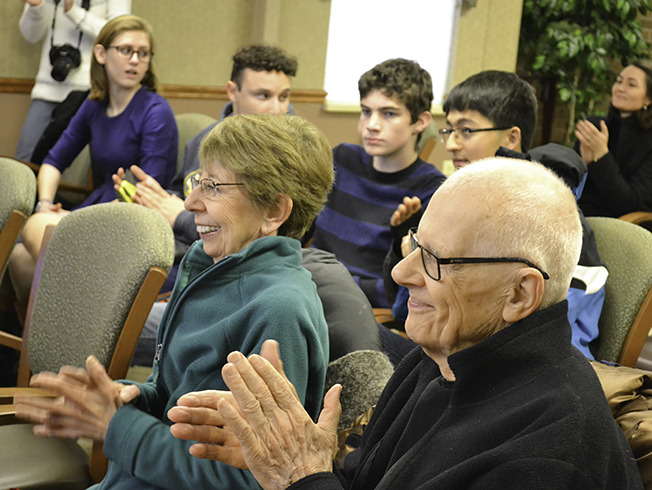
(Foreground): Two Clark-Lindsey residents appreciate a Uni High student's presentation of the device they designed.













.jpg)
















